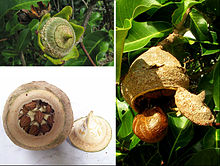Paradise nuts
| Paradise nuts | ||||||||||||
|---|---|---|---|---|---|---|---|---|---|---|---|---|

Lecythis chartacea , illustration |
||||||||||||
| Systematics | ||||||||||||
|
||||||||||||
| Scientific name | ||||||||||||
| Lecythis | ||||||||||||
| Loefl. |
The name paradise nut or sapucaia nut is used for a number of species of the genus Lecythis that occur in northern South America. The monograph by Mori and Prance describes 26 Lecythis species, which, together with the Brazil nut ( Bertholletia excelsa , the only species in the genus Bertholletia ) and eight other genera, form the neotropical subfamily of the Lecythidioideae in the potted fruit tree family (Lecythidaceae).
description
These evergreen or deciduous trees reach heights of over 40 meters, whereby the straight, knot-free trunk can be around 20 meters with a diameter of up to two meters. Usually the trunk diameter is not quite even. The heartwood is light to strong salmon-colored, the sapwood is creamy-yellow. It has no special smell or taste. The alternate leaves are simple and petiolate. The double- envelope flowers are hermaphroditic and six-fold. They have up to 1000 stamens , fertile and transformed, partly nectar-producing stamens and staminodes. The fertile ones are arranged in a ring around the ovary and the converted, partly nectar-producing and / or partly also staminodes are arranged on one side in a hat or hood that lies over the gynoeceum . The ovary is semi-subordinate to subordinate.
The woody capsule fruits "nuts" of the Lecythis species differ greatly in size, but are similar in their structure. They represent oddly shaped lidded jugs; Lid capsules , hence the botanical name “ Pyxidium ” from the Greek word pyxis for jug. As they ripen, the lids fall off, releasing the seeds, which resemble Brazil nuts, but have thinner shells and, in some species, are much larger than these. In contrast, Brazil nuts are almost round and closed, with a wart-like outgrowth as an evolutionary reminder of the original opening. When ripe, they completely fall from the tree with the seeds inside. The seeds often have a fleshy aril .
Lecythis seeds are very rich in oil (up to 75%) and are said to have a better taste than Brazil nuts.

species
The following species belong to the genus Lecythis (selection):
- Lecythis chartacea O. Berg : It is native to northern South America.
- Lecythis corrugata Poit. : It occurs in two subspecies from northern South America to northern Brazil.
- Lecythis ibiriba (Miers) NPSm., SAMori & AVPopovkin (Syn .: Chytroma ibiriba Miers ): It occurs in northeastern Brazil.
- Lecythis lanceolata Poir. ; it only occurs in Brazil.
- Lecythis minor Jacq. ; it occurs in Panama , Venezuela and Colombia .
- Lecythis ollaria L .; it occurs only in Venezuela.
- Lecythis pisonis Cambess. ; it occurs only in Brazil and Peru .
- Lecythis tuyrana Pittier ; it occurs only in eastern Panama, Colombia and northern Ecuador .
- Lecythis zabucajo Aubl. ; it occurs in tropical South America.
use
The cultivation of Lecythis species has often been recommended, but has rarely been successful, mainly because of the difficulty in protecting the nuts from animal predators.
The wood is also used for sleepers, ship keels and floors.
At the moment, Lecythis pisonis and Lecythis zabucajo in particular are used commercially.
Selenium accumulation
Many, if not all, of the Lecythis species share an interesting property with the Brazil nut. They are so-called selenium accumulators, i.e. that is, they absorb the sulfur-like element selenium from the soil and accumulate it in the seeds. You can achieve surprisingly high selenium concentrations on appropriate soils, which is why consuming too much of the nuts can lead to selenium poisoning . On the other hand, after processing, paradise nuts can be used as a dietary source of selenium, because selenium in the right amount is an important trace element that is essential for human and animal health.
literature
- AE Menninger: Edible Nuts of the World. Horticultural Books, 1977, ISBN 0-960-00464-5 , p. 37.
Web links
- Species list at Lecythidaceae Page at NYBG.
Individual evidence
- ^ SA Mori, GT Prance, Carl H. de Zeeuw: Lecythidaceae, Part 2. In: Flora Neotropica. 21 (2), The New York Botanical Garden, 1990, pp. 316-320, JSTOR i400007 .
- ↑ Brazil nut at FAO.
- ↑ a b Martin Chudnoff: Tropical Timbers of the World. USDA Forest Service. Ag. Handbook No. 607, 1984. online (PDF; 6 MB), from Forest Products Laboratory - USDA Forest Service, accessed October 18, 2018.
- ^ SA Mori: The ecology and uses of the species of Lecythis in Central America. In: Turrialba Rev. Interamer. de Cienc. Agric. 20 (3), 1970, pp. 344-50.
- ↑ Lecythidaceae in the Germplasm Resources Information Network (GRIN), USDA , ARS , National Genetic Resources Program. National Germplasm Resources Laboratory, Beltsville, Maryland. Retrieved January 27, 2014.
- ↑ a b c d e f g h i Rafaël Govaerts (ed.): Lecythis. In: World Checklist of Selected Plant Families (WCSP) - The Board of Trustees of the Royal Botanic Gardens, Kew . Retrieved September 27, 2017.
- ^ WC Kennard, HF Winters: Some Fruits and Nuts for the Tropics. Miscellaneous Publication No. 801, US Dept. of Agriculture, 1960, p. 78.
- ↑ H. Brücher: Tropical useful plants. Springer, 1977, ISBN 978-3-662-13238-8 (reprint), p. 410.
- ↑ Lecythis ( Memento of June 24, 2007 in the Internet Archive ).
- ↑ F. Kerdel-Vegas: The Depilatory and Cytotoxic Action of "Coco de Mono" (Lecythis o.). In: Econ. Bot. 20, 1966, pp. 187-195, JSTOR 4252731 .
- ^ JD Dickson: Notes on Hair and Nail Loss After Ingesting Sapucaia Nuts (Lecyth.) In: Econ. Bot. 23 (2), 1969, pp. 133-134.

